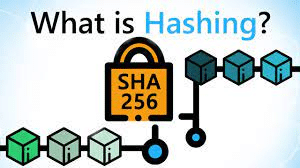
Blockchain technology is often referred to as hashing. A hash algorithm transforms input data of any length into a fixed-length string. Bitcoin’s hashing algorithm is SHA-256, a Secure Hashing 256 bits Algorithm.
Blockchain Hashing: How Does It Work?
Hashing algorithms in blockchains: what are they and how do they work? Hashes are algorithms that take an infinite number of bits, perform calculations, and produce a fixed number of bits. The output will be rectified no matter how long the input data is. In that case, the original data is referred to as input, while the final transformation is a hash. The way information is processed differently between many hashing algorithms.
Understanding the data structure is essential to understanding hashing fully. Linked lists and pointers are two vital elements of a data structure, a method for storing data. A pointer is a variable that refers to another variable, so it acts as an indicator. In addition, the next block’s address is provided as well. Pointers connect the nodes of a linked list, whereas nodes in a hierarchical list are connected.
What is the best way to solve a hash?
The process of solving a hash begins with the solution of complex mathematical problems containing data from the block header. Choosing a nonce requires some trial-and-error before a miner can begin the process. The nonce (string number) associated with the previous block’s hashed content will be the miners’ focus when a nonce is identified. An equivalent or less hash must be found to the target hash for a hash to be considered successful. To add a block to the blockchain, the miner receives a reward.
Cryptographic Hash Functions: What Are They?
Several properties make cryptographic hash functions useful when used in cryptography.
- Hash functions always produce the same result. Deterministic is used to describe this characteristic. You can enter the same message as often as you like, and the output will remain the same after applying the hash function. Even the slightest variation in input data alters the outcome.
- To be efficient, the system needs fast computation.
- Due to the preimage resistance feature in hash functions, it is computationally infeasible to determine input from the hash value. The result can only be compared until a match is found.
Hashed Data: How Is It Secured?
Except for the Genesis block, every block contains a hash of the previous block (parent block). The strings of blocks can be viewed as hashes of the parent blocks. All chain blocks are affected if the information in one block is changed. With the network’s growth, it becomes impossible to change hashes across all blocks. Hashing ensures that each element of the blockchain is unique and original, so it is necessary for the blockchain.
A blockchain’s core property is immutable and trustworthy data, making it valuable and giving it immense potential. The authenticity of the information determines blockchain integrity.
Conclusion
As a result of blockchain technology, future technology development will be determined by one of the most influential innovations of the past century. This technology is based on hashing, a cryptographic function. For mining in a blockchain and earning on it, it is essential to understand what is hashing.
FAQs
What is the length of a Bitcoin hash?
It transforms any line of text or prose into a 256-bit (32-byte) hash value using a cryptographic hash algorithm called Secure Hash Algorithm 256 (SHA-256). Words and sentences are broken down into alphanumeric strings that are fixed-length and indecipherable.
What is the difficulty of mining one bitcoin?
There is no such thing as mining one Bitcoin at a time. Instead, crypto miners mine one block at a time and are rewarded with 6.25 BTC per block. Approximately 10 minutes are required to mine each Bitcoin block. Therefore, mining one bitcoin should take just 10 minutes, in theory.






